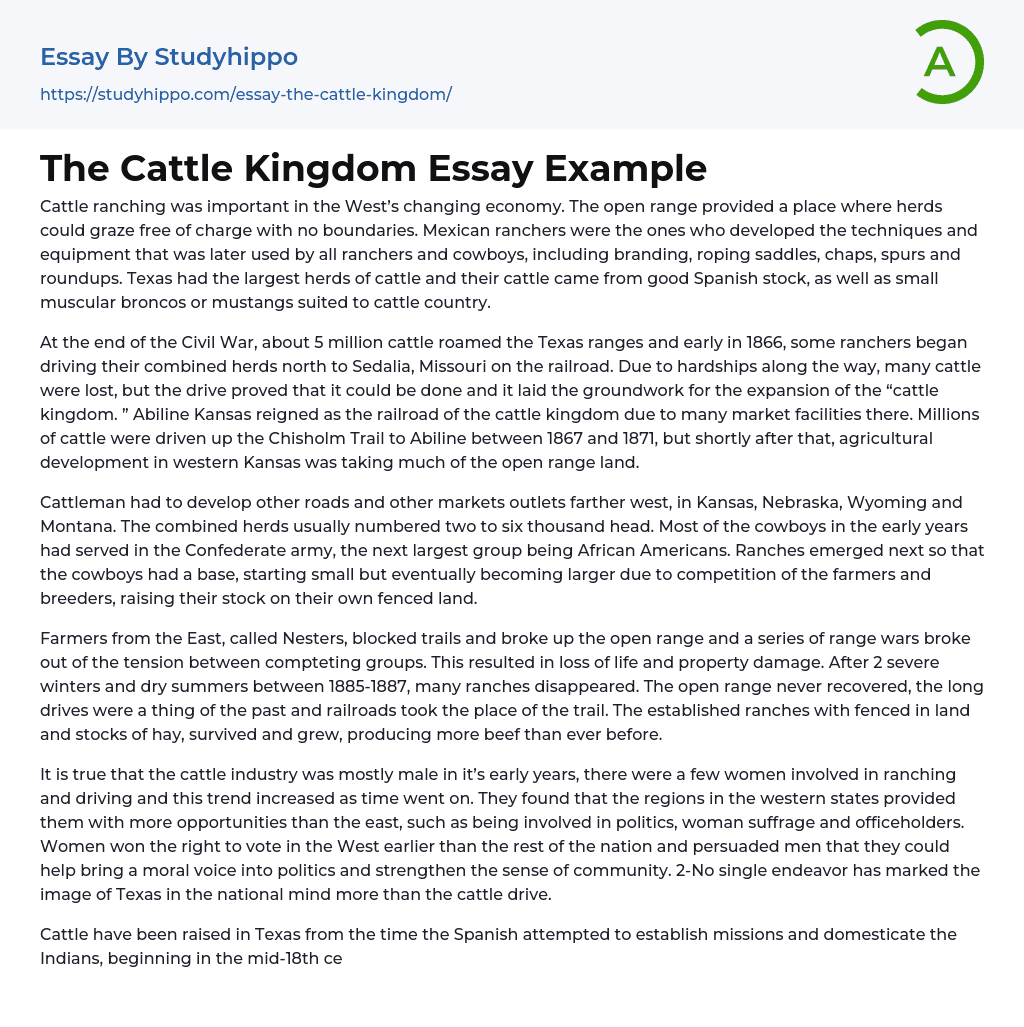The West's changing economy made cattle ranching a vital industry. The open range offered a boundary-free space for herds to graze without any cost. The techniques and equipment, such as branding, roping saddles, chaps, spurs, and roundups, were originally developed by Mexican ranchers and later adopted by all ranchers and cowboys. Texas boasted the largest cattle herds, which comprised high-quality Spanish stock and small yet robust broncos or mustangs suitable for cattle-raising regions.
At the conclusion of the Civil War, approximately 5 million cattle were freely roaming the ranges of Texas. In early 1866, certain ranchers commenced the arduous task of driving their combined herds north to Sedalia, Missouri using the railroad. While many cattle were lost due to the challenges encountered along the journey, this feat demonstrated its fe
...asibility and laid the foundation for the expansion of what became known as the "cattle kingdom." Abiline, Kansas emerged as a prominent hub within this kingdom owing to its abundance of market facilities. Between 1867 and 1871, millions of cattle were driven up the Chisholm Trail to Abiline. However, the arrival of agricultural development in western Kansas soon led to the appropriation of much of the open range land.
Cattleman expanded their operations to include roads and markets in Kansas, Nebraska, Wyoming, and Montana. They typically had herds of two to six thousand cattle. Many of the cowboys in the beginning were former Confederate soldiers, with African Americans being the next largest group. As a result of competition from farmers and breeders, ranches started to emerge as a base for cowboys, initially small but eventually growing bigger as they raised their own
livestock on fenced land.
The Nesters, or farmers from the East, disrupted trails and disintegrated the open range. This caused a series of range wars due to the tension between competing groups, resulting in casualties and property destruction. Numerous ranches vanished after enduring two harsh winters and dry summers from 1885 to 1887. The open range never made a comeback as the long drives became obsolete and railroads replaced the trails. However, the established ranches that had enclosed land and ample hay supplies persevered and expanded, leading to an unprecedented increase in beef production.
Although the cattle industry in its early years was predominantly male, a few women did participate in ranching and driving. Over time, this number increased, particularly in the western states where women found more opportunities. They were able to engage in politics, advocate for women suffrage, and even hold office. The West was ahead of the rest of the nation in granting women the right to vote. Women successfully convinced men that they could bring a moral voice into politics and contribute to a stronger sense of community. Additionally, no other activity has shaped the perception of Texas nationally as significantly as the cattle drive.
Texas has a long history of cattle raising, dating back to the Spanish attempts to establish missions and domesticate the Indians in the 18th century. Over time, the number of cattle in Texas grew rapidly, making them plentiful and causing their value to decrease. However, when the Civil War broke out in 1861, it had a devastating impact on the South's economy. While Texas had millions of cattle, there was no market
for them in the South. Ranchers found a market in the North though, where they could sell their cattle for ten times their southern value.
No more than around 260,000 people tried to cross the river during the war. As a result, the cattle business in Texas was not significantly affected until around 1866. From the traditions of the Old West and the demanding nature of the job, the Western cowboy evolved from being a mere hired help to becoming a cherished American icon. "Ranch Life And The Hunting Trail" written by Theodore Roosevelt provides insights into life and experiences in the Dakota Territory during the 1880s. Cattle and horses were left to graze freely on the open range.
During the roundup, the herds were divided, and the calves were branded with their mother's brands as a way to establish ownership of the cattle. The enduring image of a fearless and adventurous horseman living a perilous life continues to captivate. The essence of driving thousands to two thousand cattle hundreds of miles to market, braving lightning, cloudbursts, drought, stampedes, rattlesnakes, and outlaws, while sleeping under the stars remains unchanged. However, there have been some alterations in the cowboy's lifestyle in the 80s, while certain aspects of the American cowboy will always remain the same.
- Agriculture essays
- Albert einstein essays
- Animals essays
- Archaeology essays
- Bear essays
- Biology essays
- Birds essays
- Butterfly essays
- Cat essays
- Charles Darwin essays
- Chemistry essays
- Dinosaur essays
- Discovery essays
- Dolphin essays
- Elephant essays
- Eli Whitney essays
- Environmental Science essays
- Evolution essays
- Fish essays
- Genetics essays
- Horse essays
- Human Evolution essays
- Isaac Newton essays
- Journal essays
- Linguistics essays
- Lion essays
- Logic essays
- Mars essays
- Methodology essays
- Mineralogy essays
- Monkey essays
- Moon essays
- Mythology essays
- Noam Chomsky essays
- Physics essays
- Plate Tectonics essays
- Progress essays
- Reaction Rate essays
- Roman Numerals essays
- Scientific essays
- Scientific Method essays
- Scientist essays
- Seismology essays
- Space Exploration essays
- Stars essays
- Sun essays
- Thomas Edison essays
- Tiger essays
- Time Travel essays
- Universe essays




